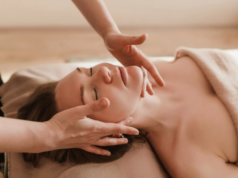Have you ever wondered why some people’s skin glows naturally, even in the biting cold of winter? The secret might just be in their kitchen, not their cosmetic bag.
Yes, Ghee is traditionally used in cooking and is also an ancient remedy for keeping the skin nourished and protected against harsh weather conditions.
Whether you’re looking to shake up your skincare routine or simply curious about natural alternatives, let’s explore the side effects and benefits of applying ghee to your face and how it can transform your skincare routine.
What is Ghee?
Ghee, or clarified butter, is a golden-yellow substance with a rich nutritional profile. It’s created by simmering butter to remove water content and milk solids, leaving behind a pure, nutrient-dense fat. Ghee has been an integral part of Indian culture for centuries and is celebrated for its versatility in cooking and therapeutic properties.
Ghee has long been used in healing and cooking traditions. Historically, it’s been used to massage pregnant women and newborns, emphasizing its gentle and nurturing qualities.
Is Ghee Beneficial for the Skin?
Ghee is packed with vitamins A, E, and K, which are essential for maintaining healthy skin. These vitamins help repair and rejuvenate skin tissue, act as a shield against environmental damage, and maintain skin elasticity. Ghee offers numerous benefits, including deep hydration and enhanced skin health, whether consumed or applied topically.
Ghee Use in Ayurveda: How Does It Work?
Ayurveda, the ancient Indian system of medicine, values ghee for its nourishing and healing properties. Ghee is particularly prized for its high concentration of butyrate, a short-chain fatty acid known for its anti-inflammatory and anti-cancer effects.
In Ayurveda, ghee balances the three doshas: Vata, Pitta, and Kapha. Its grounding and nourishing qualities make it ideal for balancing Vata, its cooling and soothing properties benefit Pitta, and its lubricating and strengthening effects help balance Kapha. Ghee is a versatile ingredient that supports overall wellness in Ayurvedic practice.
Benefits of Ghee for Skin
Indians have used ghee for generations to treat various skin issues, including dry and cracked lips, dark spots, and overall skin hydration. Ghee’s rich content of essential fatty acids, vitamins, and minerals, such as zinc and selenium, contribute to its effectiveness. Conjugated linoleic acid and omega-3 fatty acids also add more value to it in terms of their anti-inflammatory and antioxidant effects.
- Skin Health: Ghee’s essential fatty acids and vitamins promote healthy skin.
- Skin Hydration: Ghee provides deep, long-lasting hydration as a natural moisturizer.
- Skin Brightening and Smoothing: Ghee’s antioxidants help maintain a youthful glow by preventing oxidative damage.
Benefits of Applying Ghee on the Face
Applying ghee to your face can produce a natural shine, heal chapped lips, lighten dark circles, refresh the eyes, and improve overall complexion. It can even help reduce acne and delay the signs of aging. Rich in vitamins A, E, and K, ghee supports tissue repair, offers antioxidant protection, and reduces puffiness.
- Natural Shine: Ghee softens the skin, giving it a natural, healthy glow.
- Chapped Lips: Ghee is an excellent remedy for dry, chapped lips.
- Dark Circles: Regular application of ghee can lighten dark circles and refresh tired eyes.
- Complexion Improvement: Ghee helps in evening out skin tone and enhances the overall complexion.
- Anti-Aging: The vitamins in ghee help reduce the appearance of fine lines and wrinkles.
- Acne Reduction: Ghee’s anti-inflammatory properties can help reduce acne and skin irritation.
Benefits of Consuming Ghee for Skin
Consuming ghee offers internal benefits that reflect on your skin. Ghee is known to help heal cracked skin, keep it soft and supple, and delay the signs of aging. It also has moisturizing properties that help maintain skin moisture and avoid dryness from the inside.
Ghee’s anti-inflammatory properties also help soothe and heal rashes, burns, and other skin conditions. Moreover, its high CLA content aids in fat reduction and lean muscle development, promoting overall health.
Side Effects of Using Ghee on the Face
While ghee benefits many skin types, it may not suit everyone. Here are a few potential side effects to consider:
- Comedogenic: Ghee can clog pores, leading to breakouts in oily or acne-prone skin.
- Skin Sensitivity: Those with dairy sensitivities may experience redness, swelling, or itchiness.
- Patch Test: Before applying ghee on the face, it is advisable to try a patch test to see if you are allergic to it.
Takeaway
Ghee’s nourishing properties make it an excellent addition to your beauty routine. It provides deep hydration, protection, and rejuvenation for your skin. However, extra care is important if you have sensitive or oily skin. If you seek a trusted source of pure and authentic A2 ghee, we recommend exploring Ritual Roots’ ghee for the highest quality and best results.
FAQs
1. Can we apply ghee on face daily?
Applying ghee on the face daily may not be suitable for everyone. While ghee offers numerous skin benefits, including deep hydration and nourishment, it can be comedogenic for some skin types. For people with oily or acne-prone skin, ghee should be used sparingly or not at all if it is to be used as a treatment. One should do a patch test daily before using the product.
2. What are the benefits of consuming milk with ghee?
Milk with ghee benefits include improved digestion, enhanced nutritional absorption, and a boost in overall health. According to Ayurvedic principles, combining ghee with milk can help balance the body’s doshas. It also helps with digestion, boosts the immune system, and supplies the body with vitamins and minerals for the skin.
3. Is drinking milk with ghee at night good for skin health?
Drinking milk with ghee at night can benefit skin health, promoting internal hydration and nourishment. Ghee and milk together are beneficial for digestion, which in turn aids in the digestion of nutrients.
Visit here also: write for us






